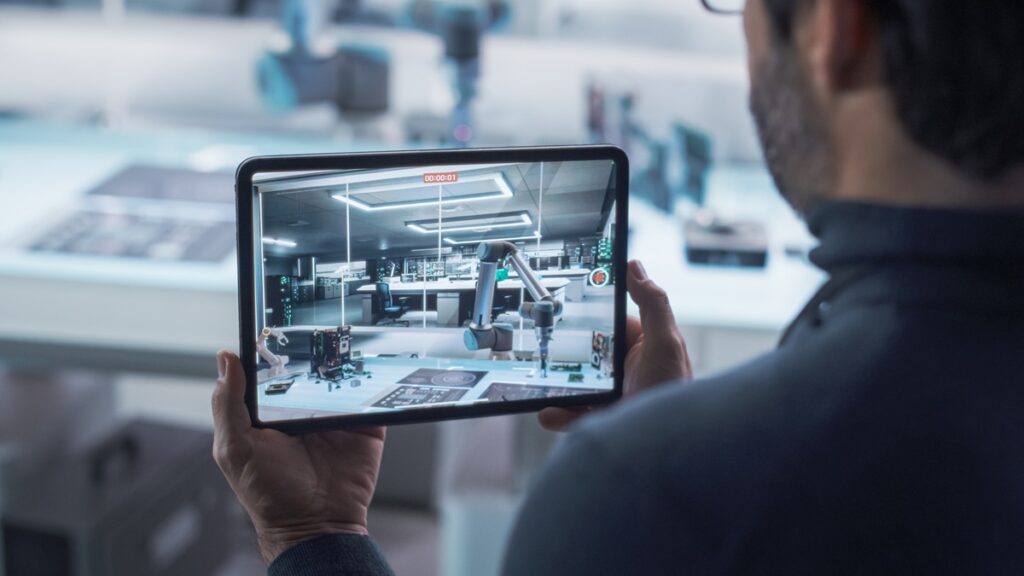ไม่ต้องสงสัยเลยว่าอุตสาหกรรม 4.0 การเปลี่ยนแปลงทางดิจิทัล ได้เปลี่ยนแปลงภูมิทัศน์การผลิตอย่างมีนัยสำคัญ เทคโนโลยี เช่น ปัญญาประดิษฐ์ (AI) และระบบอัตโนมัติ ช่วยให้ผู้ผลิตสามารถเพิ่มประสิทธิภาพ ประสิทธิภาพการดำเนินงาน การบรรลุ เพิ่มผลผลิตได้อย่างมีนัยสำคัญ (เพิ่มขึ้นจาก 15% เป็น 30%) และลดระยะเวลาหยุดทำงานลงอย่างมีนัยสำคัญ (ลดลงระหว่าง 30% และ 50%)
นวัตกรรมทางเทคโนโลยีเหล่านี้ยังนำไปสู่การเกิดขึ้นของโรงงานขนาดเล็กในวงกว้างมากขึ้น
ไมโครแฟคตอรีเป็นโรงงานขนาดเล็กที่ใช้เครื่องมือและโซลูชันที่ล้ำสมัยเพื่อให้ได้เปรียบทางการแข่งขันในขณะที่มอบระดับความยืดหยุ่นและความสามารถในการปรับขนาดใหม่ซึ่งโรงงานขนาดใหญ่แบบดั้งเดิมมักประสบความยากลำบากในการบรรลุ การใช้ AI การเรียนรู้ของเครื่องจักร บิ๊กดาต้า และเทคโนโลยีนวัตกรรมอื่นๆ ทำให้การกำจัดของเสีย การเพิ่มประสิทธิภาพกระบวนการ และการปรับแต่งส่วนบุคคลง่ายขึ้นมาก
ในขณะที่โรงงานแบบดั้งเดิมยังคงมีสิ่งที่เสนอมากมายในแง่ของ เศรษฐกิจของขนาดและประสิทธิภาพการดำเนินงานการสร้างโมดูลาร์ของโรงงานขนาดเล็กกำลังดึงดูดความสนใจ เนื่องจากผู้ผลิตสามารถผลิตผลผลิตที่มีประสิทธิภาพมากขึ้นด้วย AI และอินเทอร์เน็ตอุตสาหกรรมในทุกสิ่ง (IIoT)
แต่โรงงานขนาดเล็กที่ขับเคลื่อนด้วย AI เหล่านี้จะสามารถแทนที่โรงงานแบบดั้งเดิมได้หรือไม่ โรงงานขนาดเล็กมีความยั่งยืนมากกว่าโรงงานแบบดั้งเดิมหรือไม่
ไมโครแฟคทอรี่คืออะไร?
ประการแรก โรงงานขนาดเล็กถึงขนาดกลางมีความก้าวหน้าทางเทคโนโลยี โดยกระบวนการต่างๆ ขับเคลื่อนด้วยระบบอัตโนมัติและการเชื่อมต่อระดับสูง เมื่อเปรียบเทียบกับโรงงานแบบดั้งเดิม โรงงานขนาดเล็กใช้พลังงานและทรัพยากรบุคคลน้อยกว่าเนื่องจากมีเทคโนโลยีใหม่ที่มีประสิทธิภาพสูงกว่า จึงแทบไม่ต้องใช้แรงงานมนุษย์เลย
ลักษณะแบบโมดูลาร์ของโรงงานขนาดเล็กทำให้มีปริมาณการผลิตสูง เนื่องจากโรงงานขนาดเล็กแต่ละแห่งถือเป็น "เซลล์" ของสายการผลิตขนาดใหญ่ที่ดำเนินการงานการผลิตต่างๆ ส่งผลให้เวลาในการผลิตรวดเร็วขึ้นเมื่อดำเนินการควบคู่กัน
เพิ่มประสิทธิภาพการดำเนินงานและความยั่งยืนมากขึ้นด้วยโรงงานขนาดเล็ก
เพิ่มความคุ้มทุน
ด้วยการเปลี่ยนแปลงอย่างรวดเร็วในโรงงานสมัยใหม่ ผู้ผลิตจึงลงทุนอย่างหนักในเครื่องมือและโซลูชันเทคโนโลยีใหม่ๆ ที่เป็นนวัตกรรมเพื่อจัดการกับความต้องการที่เปลี่ยนแปลงไป การลงทุนเหล่านี้อาจเพิ่มขึ้นอย่างรวดเร็วหากโรงงานจำเป็นต้องมีการอัปเดตบ่อยครั้ง ซึ่งส่งผลกระทบต่อเวลาในการผลิต ต้นทุนผลิตภัณฑ์ และอื่นๆ อีกมากมาย
สำหรับโรงงานขนาดเล็ก ต้นทุนเหล่านี้จะลดลงมากเมื่อเทียบกับสายการผลิตแบบเดิม เนื่องจากเปลี่ยนเฉพาะเซลล์หรือส่วนประกอบบางส่วนเท่านั้น ซึ่งช่วยให้ควบคุมต้นทุนได้ด้วยการอัพเดตที่รวดเร็วขึ้นและระยะเวลาหยุดทำงานที่สั้นลง
เพิ่มความสามารถในการซ่อมแซมและความสะดวกในการบำรุงรักษา
โรงงานขนาดเล็กมีโครงสร้างแบบโมดูลาร์และ ได้มาตรฐาน ในแง่ของฮาร์ดแวร์ ซอฟต์แวร์ และโครงสร้างพื้นฐานทั่วไปเพื่อรักษาประสิทธิภาพสูงสุดและความสะดวกในการซ่อมแซม เมื่อเปรียบเทียบกับโรงงานสมัยใหม่ขนาดใหญ่ที่มีเทคโนโลยีที่ซับซ้อนและส่วนประกอบฮาร์ดแวร์ที่ปรับแต่งได้ ส่งผลให้การบำรุงรักษาโรงงานง่ายกว่า
เพิ่มความสามารถในการปรับแต่งและความเป็นส่วนตัว
ด้วยการถือกำเนิดของ IIoT, AI และเทคโนโลยีขั้นสูงอื่นๆ ลูกค้าในปัจจุบันมีทางเลือกในการรับผลิตภัณฑ์และบริการที่ปรับแต่งได้ตามความต้องการเฉพาะบุคคล ความต้องการที่เพิ่มมากขึ้นในการปรับแต่งได้นี้ทำให้เกิดความท้าทายในการผลิตที่มากขึ้นในการสร้างผลิตภัณฑ์ที่ปรับให้เข้ากับความต้องการของผู้บริโภคที่เปลี่ยนไป โรงงานขนาดเล็กสามารถตอบสนองความต้องการเหล่านี้ได้ด้วยระบบที่คล่องตัวและอัตโนมัติซึ่งช่วยให้สามารถเปลี่ยนแปลงข้อกำหนดในการผลิตได้อย่างรวดเร็ว
เพิ่มความยั่งยืนและลดปริมาณการปล่อยคาร์บอน
โรงงานขนาดเล็กใช้พลังงานและทรัพยากรน้อยกว่าโรงงานทั่วไป เนื่องจากใช้งานง่ายและดำเนินการได้ง่าย แต่ละเซลล์ในโครงสร้างพื้นฐานการผลิตสามารถจำลองแบบเป็นกลุ่มและผลิตแยกกันได้ ส่งผลให้ใช้เวลาโดยรวมน้อยลง พลังงานที่ใช้ และการปล่อยมลพิษน้อยลง นอกจากนี้ เซลล์เหล่านี้ยังสามารถเปลี่ยนได้ง่ายเมื่อเทียบกับการเปลี่ยนสายการผลิตทั้งหมด ทำให้เกิดของเสียและของเสียน้อยลง เพิ่มความเป็นวงกลมมากขึ้น.
กรณีศึกษา: โรงงานขนาดเล็กในอุตสาหกรรมยานยนต์
มีกรณีการใช้งานไมโครแฟคตอรีหลายแห่งทั่วโลกเนื่องจากมีประโยชน์อย่างมาก ตัวอย่างหนึ่งคือผู้ผลิตยานยนต์จากสหราชอาณาจักร การมาถึง.
Arrival มีความเชี่ยวชาญด้านการผลิตยานยนต์ไฟฟ้า โดยผลิตผ่านโรงงานขนาดเล็กแบบกระจายศูนย์ที่มีกระบวนการอัตโนมัติสูง โรงงานขนาดเล็กเหล่านี้ใช้หุ่นยนต์และซอฟต์แวร์ขั้นสูงที่ช่วยให้สายการผลิตปรับตัวตามการเปลี่ยนแปลงได้อย่างรวดเร็วโดยไม่ต้องมีการแทรกแซงจากมนุษย์ นอกจากนี้ โรงงานขนาดเล็กยังใช้ส่วนประกอบคอมโพสิตที่เบากว่าและแข็งแรงกว่า ช่วยลดขยะวัสดุและต้นทุน
เซลล์ไมโครแฟกทอรีของ Arrival ยังใช้ฮาร์ดแวร์แบบโมดูลาร์เพื่อให้ประกอบได้ง่ายขึ้น เข้ากันได้และเปลี่ยนใหม่ได้เมื่อจำเป็น ด้วยเหตุนี้ Arrival จึงสามารถปรับแต่งได้ในระดับที่สูงขึ้นเพื่อตอบสนองความต้องการของลูกค้า ขณะเดียวกันก็ลดของเสียที่อาจเกิดขึ้นได้
เมื่อพิจารณาถึงปัจจัยทั้งหมดนี้ Arrival ได้เพิ่มผลผลิตและความยืดหยุ่นสูงสุดโดยมีต้นทุนด้านสิ่งแวดล้อมและทางการเงินที่ต่ำลงมาก โดยอาศัยการตั้งค่าโรงงานขนาดเล็ก
การเปลี่ยนแปลงทางดิจิทัลและโรงงานแห่งอนาคต
หากนำไปปฏิบัติอย่างถูกต้อง การเปลี่ยนแปลงทางดิจิทัลสามารถให้ผลลัพธ์ที่สำคัญได้ อย่างไรก็ตาม ความท้าทายที่ผู้ผลิตหลายรายเผชิญคือไม่ทราบว่าตนเองกำลังดำเนินไปในจังหวะที่เหมาะสมสำหรับอุตสาหกรรมของตนหรือไม่ และขาดการมองเห็นในด้านเฉพาะที่จำเป็นต้องปรับปรุง ซึ่งท้ายที่สุดแล้ว สิ่งนี้ทำให้พวกเขาไม่สามารถมองเห็นได้ชัดเจนว่าตนเองกำลังดำเนินไปในเส้นทางที่ถูกต้องในการเปลี่ยนแปลงทางดิจิทัลสู่ Industry 4.0 หรือไม่
ผู้ผลิตจะได้รับข้อมูลและการวิเคราะห์ที่เป็นประโยชน์ต่อการพัฒนาตนเองในกระบวนการเปลี่ยนแปลงได้ก็ต่อเมื่อมีเครื่องมือและกรอบการทำงานด้านการประเมินประสิทธิภาพที่เหมาะสมเท่านั้น ดัชนีความพร้อมของอุตสาหกรรมอัจฉริยะ (SIRI) ช่วยให้ผู้ผลิตไม่ว่าจะมีขนาดหรืออยู่ในอุตสาหกรรมใดสามารถประเมินระดับความพร้อมด้านดิจิทัลของตนได้ผ่านการประเมินที่ครอบคลุม นอกจากนี้ ดัชนีความพร้อมด้านอุตสาหกรรมอัจฉริยะยังให้คำแนะนำและการสนับสนุนผ่านแผนงานการเปลี่ยนแปลงที่สร้างขึ้น จึงช่วยให้ผู้ผลิตสามารถเปิดเผยเส้นทางที่ชัดเจนยิ่งขึ้นสู่การนำ Industry 4.0 มาใช้ และช่วยให้พวกเขาบรรลุเป้าหมายด้านประสิทธิภาพการดำเนินงานได้
เรียนรู้เพิ่มเติมเกี่ยวกับดัชนีความพร้อมของอุตสาหกรรมอัจฉริยะ ที่นี่ หรือติดต่อเราได้ที่ ติดต่อ@incit.org เพื่อเริ่มการสนทนา


